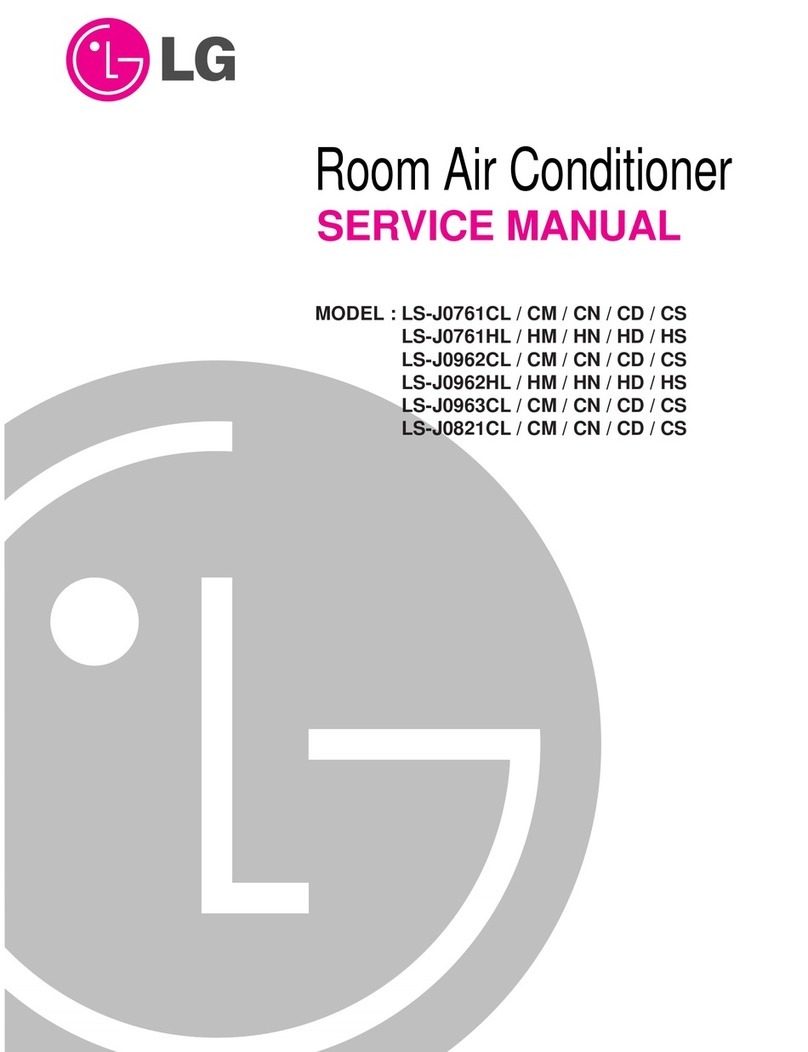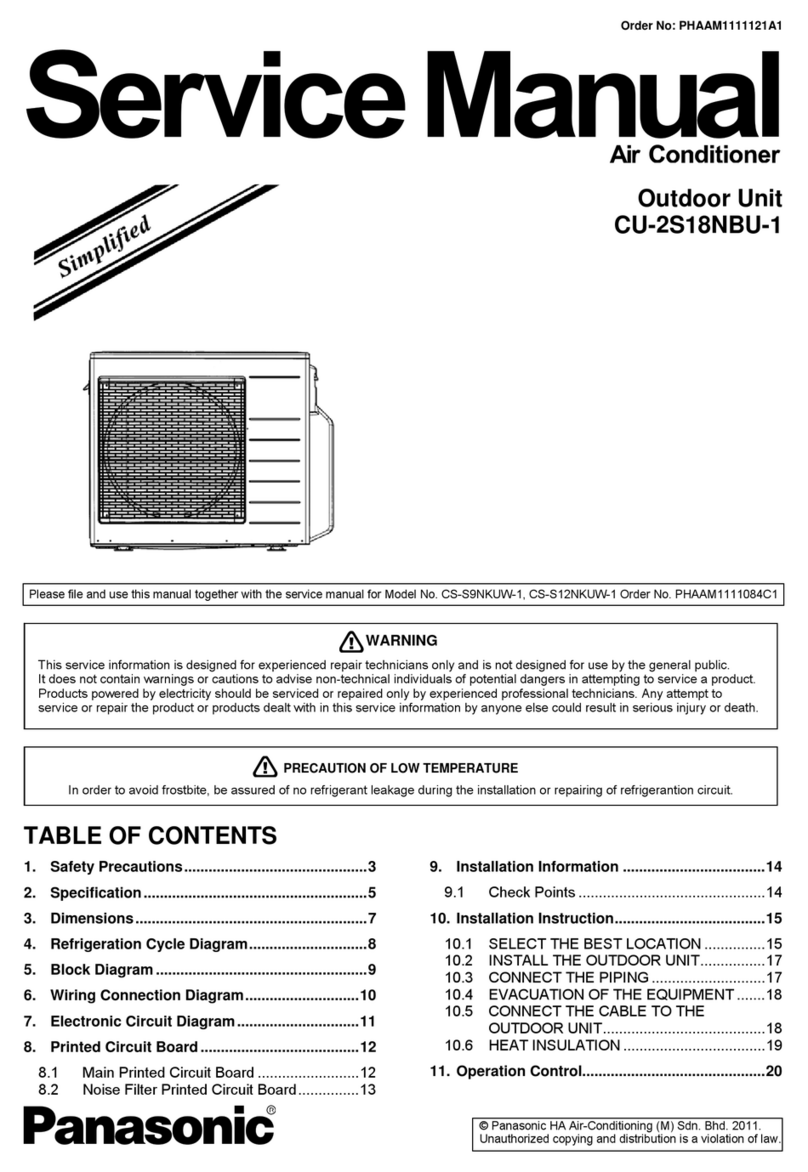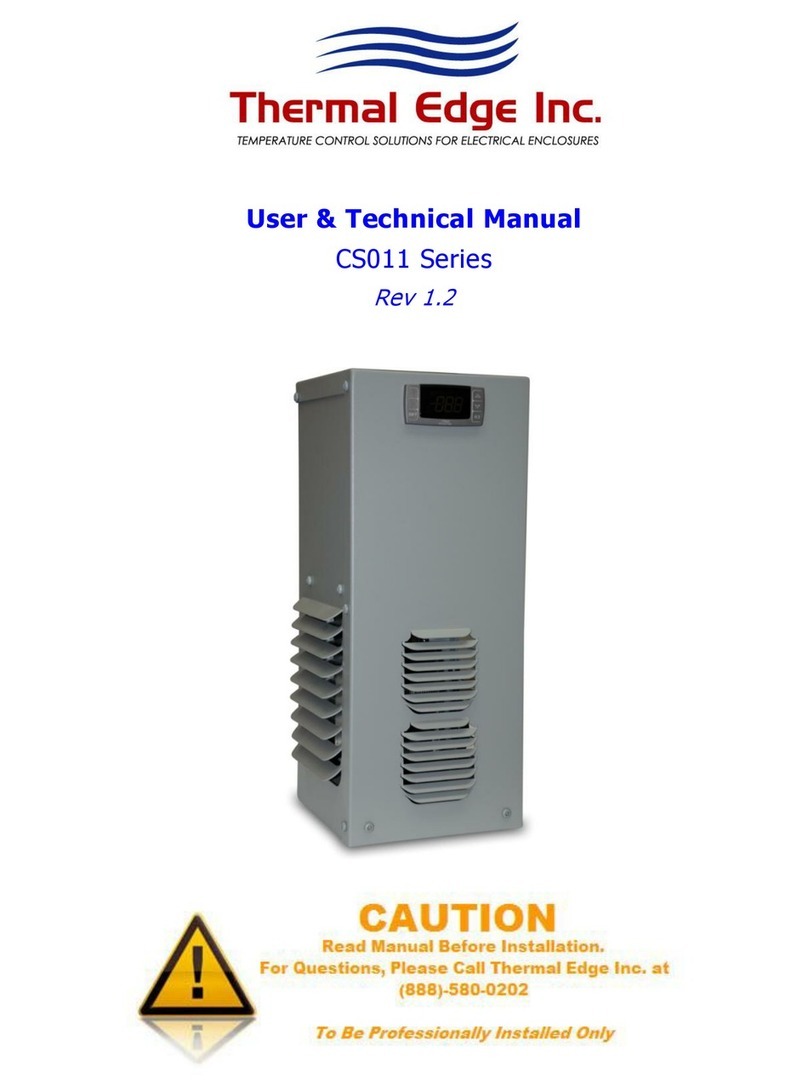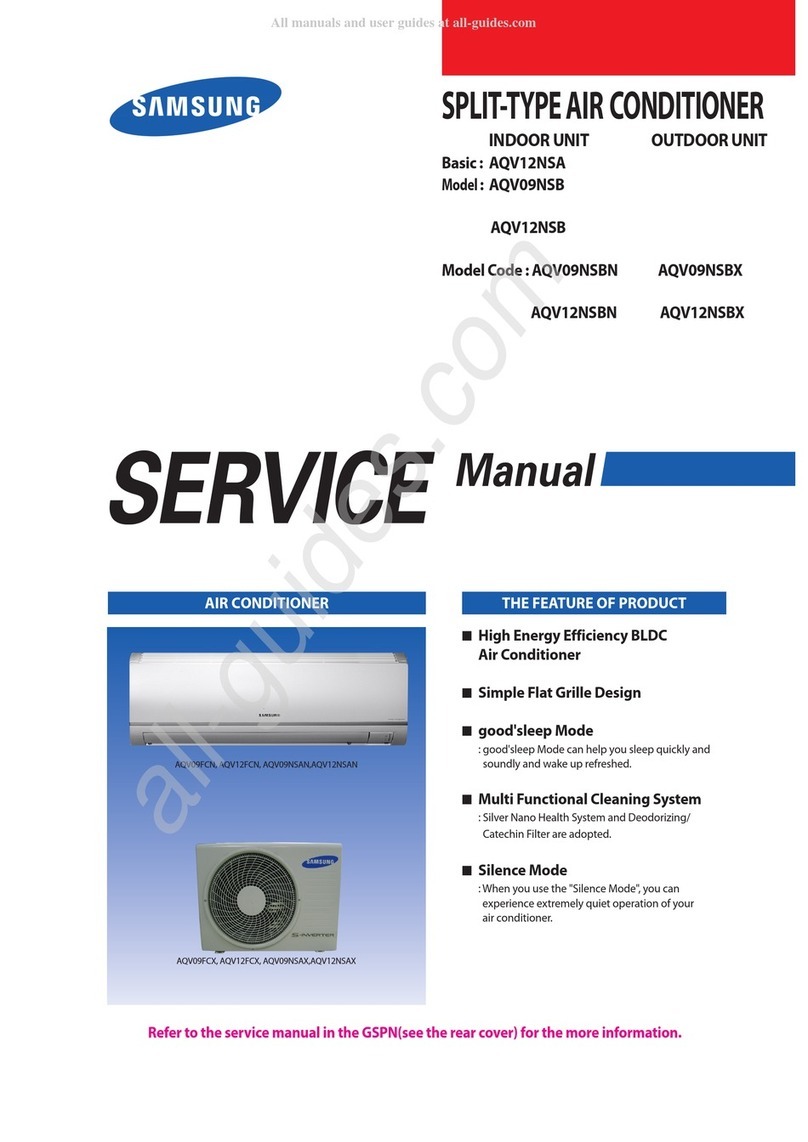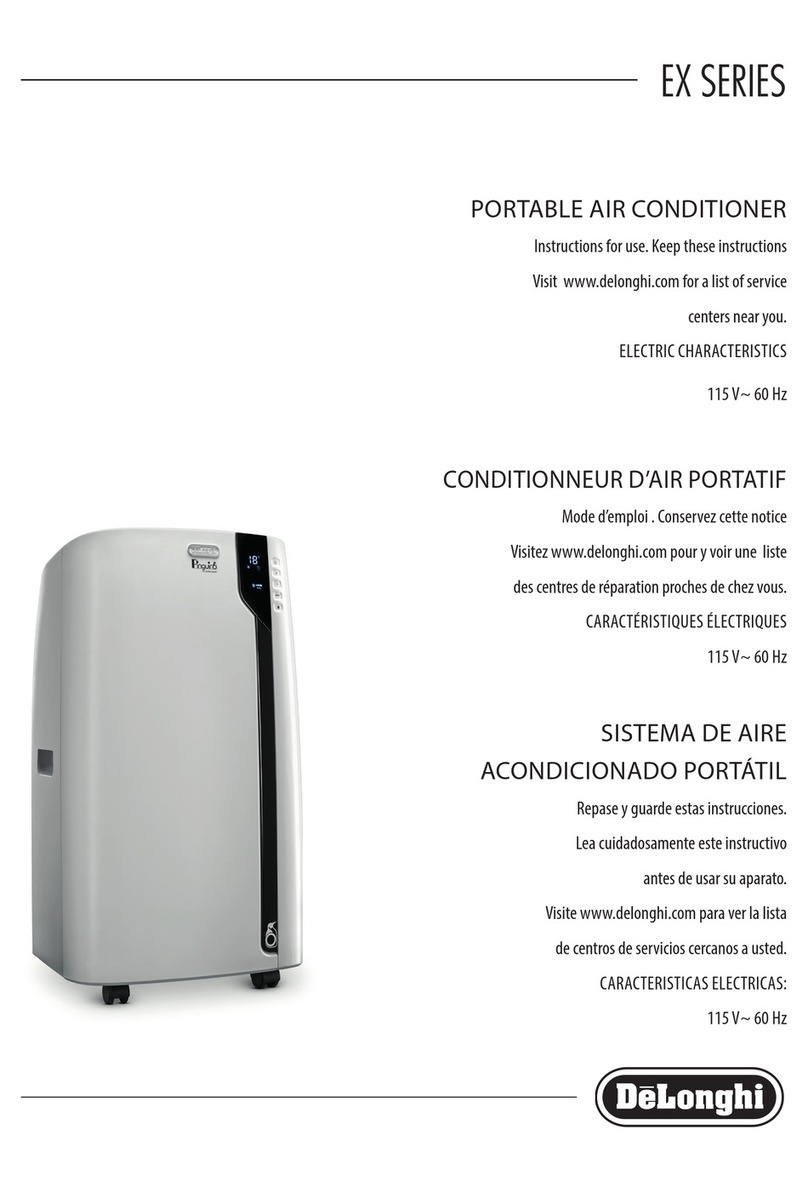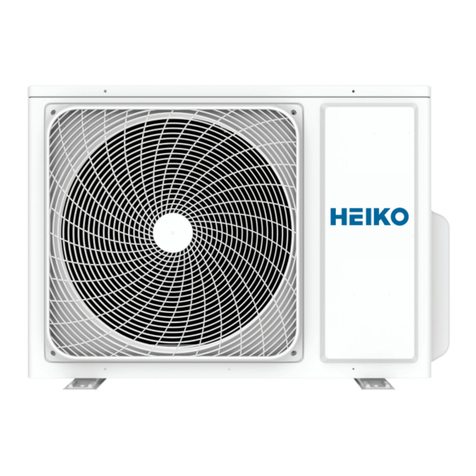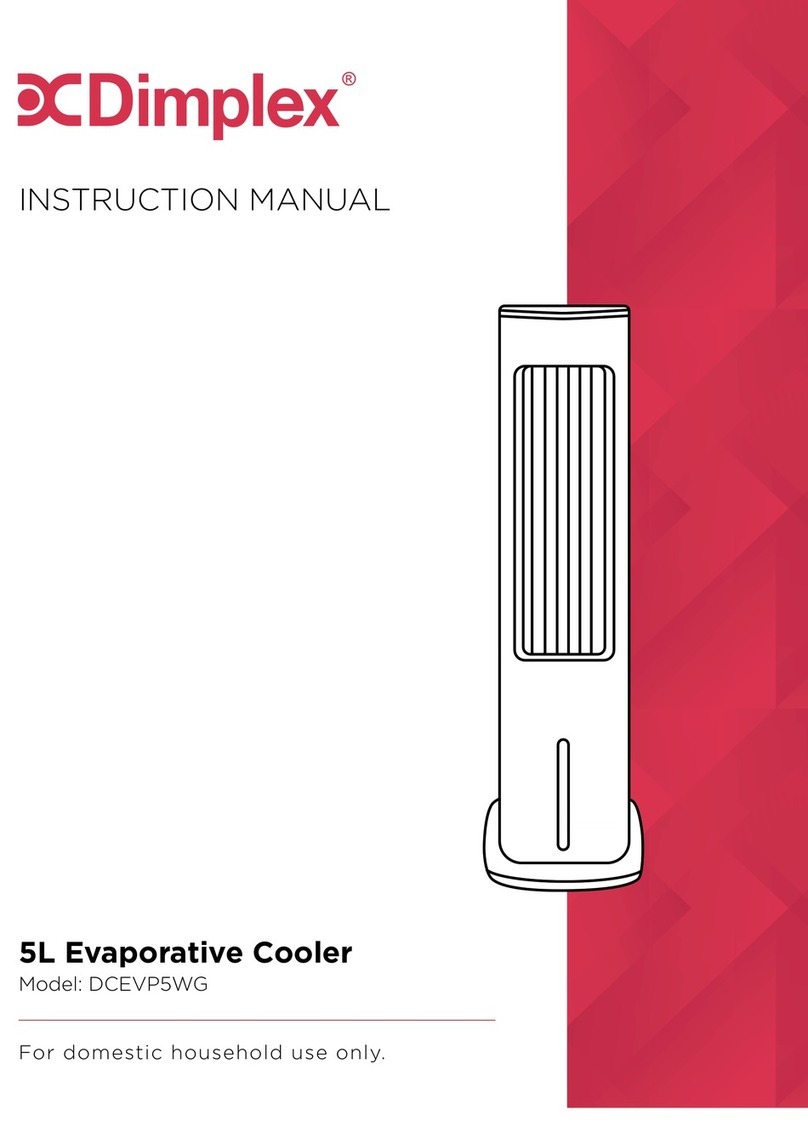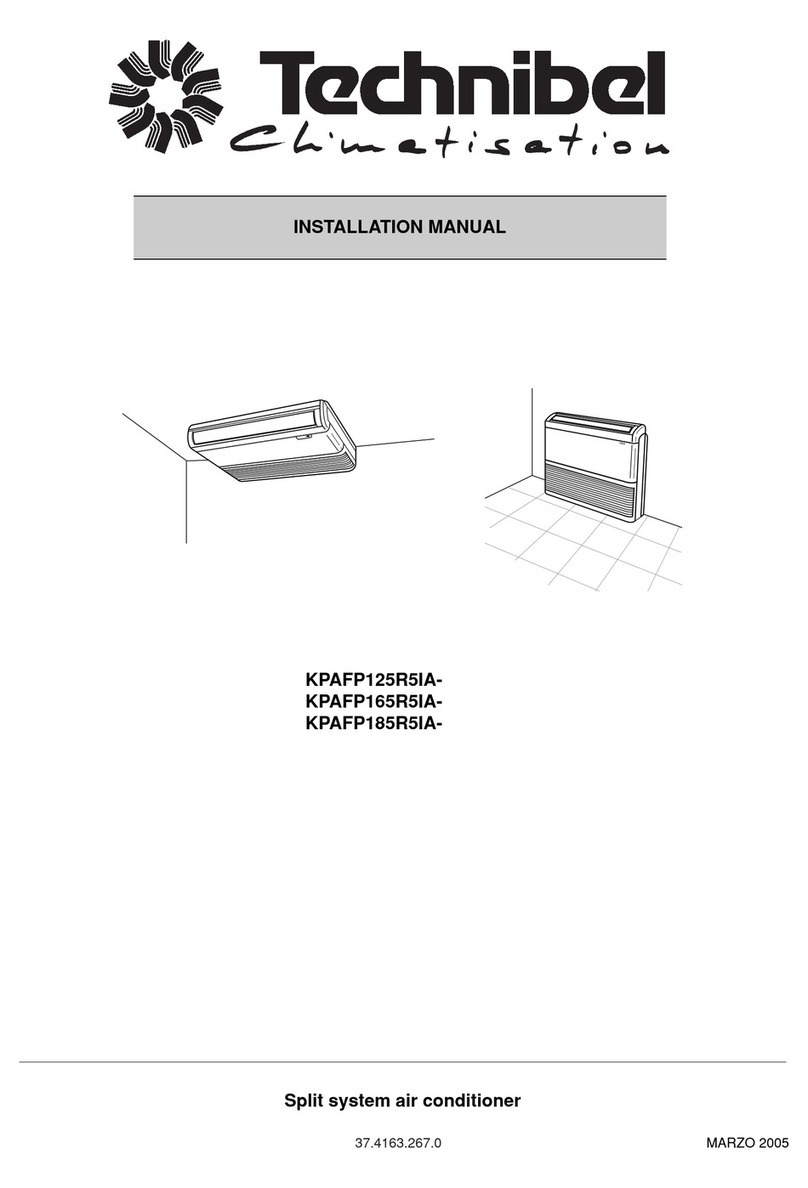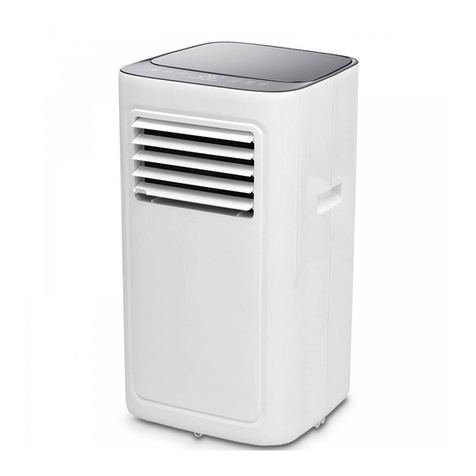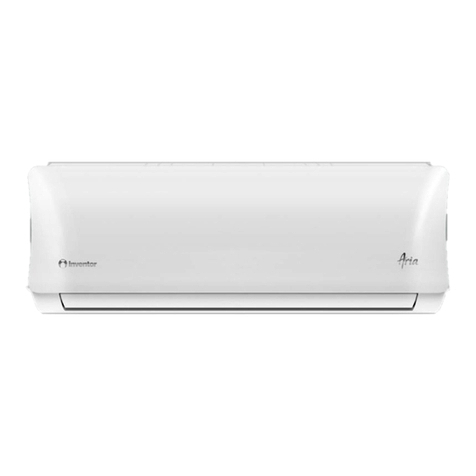Ghibli PDC series User manual

1
INSTALLATION MANUAL
GHIBLI PDC
INSTALLATION MANUALGHIBLI PDC
DETRAZIONE
FISCALE
ALTA
EFFICIENZA
RISPARMIO
ENERGETICO
INSTALLAZIONE
FACILE
ENERGIA
RINNOVABILE
DIMENSIONI
COMPATTE
FUNZIONE
A BASSA
TEMPERATURA
VENTILAZIONE
SILENZIOSA
AUTORESTART
DI SERIE
GAS
ECOLOGICO

2

3
1
·CAREFULLY FOLLOW THE INSTRUCTIONS BELOW TO ENSURE THE IDEAL OPERA-
TION OF THE AIR CONDITIONER.
·
HANDLE THE UNIT WITH CARE AND NEVER TURN THE AIR CONDITIONER UPSIDEDOWN
DURING INSTALLATION
.
·NEVER REMOVE THE UNIT'S REAR PANEL FOR ANY REASON IN ORDER TO AVOID
COMPROMISING OPERATION.
·AT THE END OF INSTALLATION, EXPLAIN THE UNIT'S OPERATION TO THE CLIENT
USING THE OPERATION AND MAINTENANCE MANUAL.
·GIVE THE OPERATION AND MAINTENANCE MANUAL TO THE CUSTOMER.
·THE UNIT INSTALLATION IS FOR QUALIFIED STAFF ONLY.
·THE UNIT MUST BE INSTALLED FOLLOWING THE NATIONAL REGULATIONS.
·THE POWER SUPPLY PLUG MUST BE ACCESSIBLE AFTER THE UNIT INSTALLATION.
·
IF THE POWER SUPPLY CABLE IS DAMAGED, IT MUST BE SUBSTITUTED EXCLUSIVELY
BY THE MANUFACTURER OR BY AUTHORISED TECHNICAL ASSISTANCE CENTRE, IN
ORDER TO PREVENT ANY RISK.
Installation Manual

4
2
Fig. 1
The position of the air conditioner is extremely important for both correct operation and the comfort of the room or area.
Choose the unit's position together with the customer while taking into consideration the following points:
A. The air must be distributed as evenly as possible throughout the room, taking into consideration that warm air tends to rise and
cool air tends to fall;
B. The flow of air emitted by the unit must never strike the room's occupants directly;
C. Internal units must never be obstructed by furniture or curtains, etc.;
D.We recommend installing the unit at least 20 cm above the floor in order to permit complete and correct air distribution in the
room. A distance of at least 15 cm must be kept from the ceiling (see Fig. 1) in order to permit correct wall or built-in installation;
E. The rear ventilation grills must be free from obstacles to permit a free flow of air;
F. Make sure that the flow of air expulsed from the rear grills does not disturb the neighbours and is not directed to an area with a
continuous passing of pedestrians;
G. The flow of air from the rear grills must not be sent into a closed room because if this expulsed air is injected into an area
without free circulation the temperature will rise and the unit will begin malfunctioning with lower yield;
H. The unit's controls must be easily accessible to facilitate routine maintenance operations;
I. The condensate produced during operation must be eliminated without creating disturbance to anyone.
1. SELECTING THE INSTALLATION POSITION
These are just a few of the basic rules for air condi-
tioner installation. In case of unusual situations or
doubts regarding feasibility (dimensions, positio-
ning, etc.) please contact your nearest Technical
Assistance Center or your Manufacturer's techni-
cal/commercial contact person.

5
3
We provide an installation diagram below that summarises all the information found in the respective chapters that explain the various
types of installation possible:
Wall installation (page 6)
Built-in installation (page 9)
section
section
Installation to the edge of the wall (page 12)
section
Wall bracket
Wall bracket

6
ASSEMBLY PROCEDURE
1. Position the supplied paper template on the wall and using a pencil mark the positions of the two holes to be drilled and the posi-
tion of the support bracket at a height of around 340 mm from the floor.
Unusual installation positions must be worked out case by case.
Whenever the paper template has not been provided, see the dimensions shown in the drawing on Page 14.
2. Drill adequate holes for the suction and expulsion of the air using drill bits.
These holes must slope slightly downward by approximately 0.5 cm from the inside to the outside in order to prevent rain or dirt from
entering the room and the air conditioner.
3. Drill the holes for the fastening of the air conditioner support bracket. The support bracket must be fastened using expansion bolts
of no less than 1 cm while also bearing in mind the type of wall in which the air conditioner will be installed and that the air conditio-
ner is heavier on its right side (looking at the wall from inside the room).
IMPORTANT:whenever auxiliary condensate drainage will be provided
(see the respective paragraphs on Page 15) provide an adequate recess in the
wall.
4. Insert the plastic pipes of diameter and length adequate to the depth of the
wall into the holes drilled for air suction and expulsion, making sure that the
pipe lined with condensate-proof material can be fitted into hole A as shown
in Figure 1.
N.B.: The air inlet and outlet pipes supplied have a maximum length of 400
mm; for this reason, if the depth of the wall is less, these pipes must be cut.
For installations with pipes longer than 400 mm, please contact your neare-
st Technical Assistance Center or your Manufacturer's technical/commercial
contact person.
5. Make sure that the air expulsion pipe (hole A in Figure 1) is lined with
condensate-proof insulation material along its entire length.
Whenever the kit supplied is not used, remember to internally line the air
expulsion pipe (to be fitted in hole A in Figure 1) with condensate-proof
material for its entire length.
6. Apply junk rings or appropriately insulated flanges on the pipes in order
to guarantee ideal contact between the air conditioner and the holes.
IMPORTANT: the cut flange must be applied near hole A shown in Figure 1
where the insulated pipe will be connected.
2. WALL INSTALLATION
IMPORTANT: Cordon off the outdoor area immediately beneath the installation area to prevent falling masonry debris or
chunks of plaster from damaging or injuring property and people below.
Make sure that there are no electric hoses or gas or water pipes inside the parts of the wall to be drilled.
IMPORTANT: THE UNIT MUST BE INSTALLED FOLLOWING THE NATIONAL REGULATIONS.
fig.1
A air expulsion hole
B air suction hole
C support bracket
A
C
B
min 340 mm
4

7
7. Condensate drain preparation
Whenever the unit must be removed, make sure to first drain the condensate collection tray to avoid annoying water spills.
During transport, always leave the air conditioner positioned upright on a flat surface and never rest it on its front plastic
part or on its rear part.
N.B.: Whenever it is impossible to send all the condensate created outside the room, see the paragraph “Auxiliary condensate draina-
ge” on Page 15.
fig. 2
Electric heating
element
Pipe
fig. 3
Assemble the condensate drainage pipe by firmly pushing and twisting it towards the air conditioner as shown in Figures 2 and 3,bearing
in mind that incorrect fastening can cause water leakage.
IMPORTANT: the electric heating element must be inserted inside the condensate drainage in order to prevent water from freezing insi-
de the pipe in low-temperature installations.
Cut the length of pipe as required depending on how far it must protrude outside, bearing in mind that it must protrude from the air
hosing sealing grill by 1 cm.
IMPORTANT: make sure that the downward inclination of the condensate drainage outwards is in the range of from 4 to 5% (fig. 4):
slowly pour water into the condensing unit's condensate collection tray and then make sure that the pipe prepared above drains this water
correctly.
IMPORTANT: The cutting of the electric heating element is absolutely prohibited in order to avoid creating serious operating
problems (short-circuits or other malfunctions) to the unit.
In order to reduce the length of the electric heating element, just pull it inside the unit as shown in Figures 5 - 6 - 6.1 - 6.2 - 6.3.
fig. 4 fig. 5 fig. 6
5
SECTION
Wall bracket
4-5%
fig. 6.1 fig. 6.2 fig. 6.3
OKOK
NO!!

8
8. Installation of the unit
IMPORTANT: Handle the unit with care paying extra attention to avoid damaging or scratching the parts of the unit that will remain
in view.
Hang the air conditioner to the bracket provided by passing the condensate drainage pipe correctly along the air expulsion pipe and
then checking the unit's stability.
Air pipe (inlet)
Air conditioner
The pipe protection grills must be applied outside the wall where the unit is installed. Cut
part of the right grill (looking at the unit from the rear) in order to permit the condensate
drainage pipe to exit correctly (see Figure).
9. Rear grills
At the end of installation, the grills must be applied to the air circulation pipes.
As above, this particular measure will ensure better unit operation because not only will the air be filtered and therefore the heat
exchange system will remain cleaner (and maintain yield over a longer period of time), but also will prevent the deposit of leaves or
other clogging material in the pipes and infiltration by birds or other small animals.
These grills can be quickly removed and cleaned whenever necessary.
AIR SUCTION
VIEW OF AIR CONDITIONER REAR GRILLS
AIR EXPULSION
CONDENSATE
DRAINAGE
10. Connect the air conditioner to the power supply by plugging in the plug. Before starting, make sure that the plug is adequate to the
air conditioner's power absorption and the regulations in force.
6
Rear grills
Electric heating element
Insulated air pipe (outlet)
Wall bracket
Internal condensate
drainage pipe

9
ASSEMBLY PROCEDURE
1. Position the supplied paper template on the wall and using a pencil mark the
position of the hatch to be made in the wall (see the recess outline on the refe-
rence template).
Unusual installation positions must be worked out case by case.
Whenever the paper template has not been provided, see the dimensions
shown in the drawing on Page 14.
2. Make an opening of adequate depth in the wall bearing in mind that the unit's
recessed section has a maximum depth of 235 mm and a minimum depth of 185
mm (see Figure 3).
3. Consulting the reference measurements provided on the template, drill ade-
quate holes for the suction and expulsion of the air using drill bits.
These holes must slope slightly downward by approximately 0.5 cm from the
inside to the outside in order to prevent rain or dirt from entering the room and
the air conditioner.
3a. Consider the idea of preparing a compartment for the air conditioner's power
supply inside the opening in the wall, making sure that it will not create pro-
blems subsequently during the insertion of the unit.
4. Insert the plastic pipes of diameter and length adequate to the depth of the
wall into the holes drilled for air suction and expulsion, making sure that the
pipe lined with condensate-proof material can be fitted into hole A as shown in
Figure 1.
N.B.: The air inlet and outlet pipes supplied have a maximum length of 400
mm; for this reason, if the depth of the wall is less, these pipes must be cut. For
installations with pipes longer than 400 mm, please contact your nearest
Technical Assistance Center or your Manufacturer's technical/commercial con-
tact person.
5. Make sure that the air expulsion pipe (hole A in Figure 2) is lined with con-
densate-proof insulation material along its entire length.
Whenever the kit supplied is not used, remember to internally line the air expul-
sion pipe (to be fitted in hole A in Figure 2) with condensate-proof material for
its entire length.
6. Apply junk rings or appropriately insulated flan-
ges on the pipes in order to guarantee ideal contact
between the air conditioner and the holes (see
Figure 4).
IMPORTANT: the cut flange must be applied near
hole A shown in Figure 2 where the insulated pipe
will be connected.
854
440
3. BUILT-IN INSTALLATION
IMPORTANT: Make sure that the thickness and type of wall are adequate to flush-mount air conditioner installation.
IMPORTANT: Cordon off the outdoor area immediately beneath the installation area to prevent falling masonry debris or
chunks of plaster from damaging or injuring property and people below.
Make sure that there are no electric hoses or gas or water pipes inside the parts of the wall to be drilled.
IMPORTANT: THE UNIT MUST BE INSTALLED FOLLOWING THE NATIONAL REGULATIONS.
fig. 1
fig. 2
A air expulsion hole
B air suction hole
7
Wall bracket
115 mm
300 mm
185 mm
fig. 3
AB
fig. 4

10
7. condensate drain preparation
Whenever the unit must be removed, make sure to first drain the condensate collection tray to avoid annoying water spills.
During transport, always leave the air conditioner positioned upright on a flat surface and never rest it on its front plastic
part or on its rear part.
N.B.: Whenever it is impossible to send all the condensate created outside the room, see the paragraph “Auxiliary condensate draina-
ge” on Page 15.
Assemble the condensate drainage pipe by firmly pushing and twisting it towards the air conditioner as shown in Figures 6 and 7,bearing
in mind that incorrect fastening can cause water leakage.
IMPORTANT: the electric heating element must be inserted inside the condensate drainage in order to prevent water from
freezing inside the pipe in low-temperature installations.
Cut the length of pipe as required depending on how far it must protrude outside, bearing in mind that it must protrude from the air
hosing sealing grill by 1 cm.
IMPORTANT: make sure that the downward inclination of the condensate drainage outwards is in the range of from 4 to 5% (fig. 8):
slowly pour water into the condensing unit's condensate collection tray and then make sure that the pipe prepared above drains this water
correctly.
IMPORTANT: The cutting of the electric heating element is absolutely prohibited in order to avoid creating serious operating
problems (short-circuits or other malfunctions) to the unit.
In order to reduce the length of the electric heating element, just pull it inside the unit as shown in Figures 9 - 10 - 10.1 - 10.2 - 10.3.
fig. 9 fig. 10
8
fig. 6
Electric heating
element
Pipe
fig. 7
fig. 8
SECTION
Wall bracket
4-5%
fig. 10.1 fig. 10.2 fig. 10.3
OKOK
NO!!

11
Rear grills
Electric heating element
Insulated air pipe (outlet)
Air pipe (inlet)
Wall bracket
Air conditioner
Internal condensate
drainage pipe
The pipe protection grills must be
applied outside the wall where the unit is
installed. Cut part of the right grill
(looking at the unit from the rear) in
order to permit the condensate drainage
pipe to exit correctly (see Figure).
10. Connect the air conditioner to the
power supply by plugging in the plug.
Before starting, make sure that the plug
is adequate to the air conditioner's
power absorption and the regulations in
force.
9. Rear grills
At the end of installation operations, the grills must be applied to the air circulation pipes.
As above, this particular measure will ensure better unit operation because not only will the air be filtered and therefore the heat
exchange system will remain cleaner (and maintain yield over a longer period of time), but will also prevent the deposit of leaves or
other clogging material in the pipes and infiltration by birds or other small animals.
These grills can be quickly removed and cleaned whenever necessary.
AIR SUCTION
VIEW OF AIR CONDITIONER REAR GRILLS
AIR EXPULSION
CONDENSATE
DRAIN
9
8. Installation of the unit
IMPORTANT: handle the unit with care paying extra attention to avoid damaging or scratching the parts of the unit that will remain
in view.
IMPORTANT: whenever the opening in the wall made for the unit is not equipped for the connection to the electrical power supply,
remember to make an adequate opening in the wall for the exit of the air conditioner's power supply cable.
Insert the unit into the recess made in the wall and pass the condensate drainage hose along the air expulsion pipe and check the stabi-
lity of the air conditioner. Push the unit in towards the wall behind it.

12
10
·IMPORTANT: Make sure that the thickness and type
of wall are adequate to flushmount air conditioner
installation.
·IMPORTANT: Cordon off the outdoor area immedia-
tely beneath the installation area to prevent falling
masonry debris or chunks of plaster from damaging
or injuring property and people below.
·IMPORTANT: The unit is provided with power sup-
ply cable only for indoor installation. In case of edge
of the wall installation, the power supply cable must
be substituted with a flexible cable with polychloro-
prene sheath like H05RN-F or H07RN-F.
·Make sure that there are no electric hoses or gas or
water pipes inside the parts of the wall to be drilled.
·IMPORTANT: THE UNIT MUST BE INSTALLED
FOLLOWING THE NATIONAL REGULATIONS.
1.
Position the supplied paper template on the wall and using a
pencil mark the position of the hatch to be made in the wall (see
the recess outline on the reference template).
Unusual installation positions must be worked out case
by case.
ASSEMBLY PROCEDURE
Fig. 1
854
440
420 mm
440 mm
4. INSTALLATION TO THE EDGE OF THE WALL
4.1

13
2. Make an opening of adequate depth in the wall using the
supplied paper template bearing in mind that the unit’s
recessed section has a maximum depth of 235 mm and a
minimum depth of 180 mm (see fig. 2).
3. Consider the idea of preparing a compartment for the air
conditioner’s power supply inside the opening in the wall,
making sure that it will not create problems subsequently
during the insertion of the unit.
4. Place the air conditioner through the wall hatch, and make
sure that the end of the air conditioner skims the outdoor wall
profile (see fig. 3). Seal the rift with opposite resins, in order
to avoid the water and the insect entrance.
5. Place along the frontal (A) and rear (B) side a
thermal/noise proof material (thickness 50 mm) in order to
avoid noise, air and heat passage from the unit to the room
and outdoor ambient and viceversa (see fig. 3).
6. Condensate drain preparation
Assemble the condensate drainage pipe by firmly pushing
and twisting it towards the air conditioner (see figure 6 page
8), bearing in mind that incorrect fastening can cause water
leakage.
IMPORTANT: the electric heating element must be
inserted inside the condensate drainage in order to pre-
vent water from freezing inside the pipe in low-tempera-
ture installations.
NOTE: cut the galvanized metal sheet of rear side as
indicated in the drawing (fig. 4).
fig. 2
fig. 3
420 mm
440 mm
11
A
B
fig. 4

14
12
fig. 6
fig. 7
Cut the length of pipe as required depending on how far it
must protrude outside, bearing in mind that it must protrude
from the air hosing sealing grill by 1 cm.
IMPORTANT: make sure that the downward inclination of
the condensate drainage outwards is in the range of from 4 to
5% (fig. 5): slowly pour water into the condensing unit’s
condensate collection tray and then make sure that the pipe
prepared above drains this water correctly.
IMPORTANT: the cutting of the electric heating element
is absolutely prohibited in order to avoid creating serious
operating problems (short-circuits or other malfunc-
tions) to the unit.
In order to reduce the length of the electric heating element,
just pull it inside the unit as shown in fig. 6 - 7 -7.1 - 7.2 -
7.3.
Whenever the unit must be removed, make sure to first
drain the condensate collection tray to avoid annoying
water spills. During transport, always leave the air condi-
tioner positioned upright on a flat surface and never rest
it on its front plastic part or on its rear part.
N.B.: Whenever it is impossible to send all the condensate
created outside the room, see the paragraph “Auxiliary con-
densate drainage”on page 15.
6. Outdoor grille
On request, it is possible to supply a special grille to be pla-
ced on the outdoor wall (see fig. 8).
fig. 5
fig. 8
4-5%
fig. 7.1
fig. 7.2
fig. 7.3
OK
OK
NO!!

15
13
Pump
Pump
Continuity tank
Continuity tank
a. Wall installation
b. Built-in installation
This kit is composed of a pump and pipe fittings
that permit to carry the water self-produced in the
air conditioner onto condensers, in order to elimi-
nate it through evaporation, optimising the unit
efficiency. This kit is installed by the manufacturer.
INSTALLED BY MANUFACTURER
The water in the (continuity tank) could last up to
5 - 6 hours depending on the ambient humidity.
When it is exhausted, the user can fill the conti-
nuity tank then the air conditioner restarts working
at HIGH EFFICIENCY.
The “Drain exit” must be closed, the auxiliary
“Extra drain” outlet is connected to the pump in
order to recover the dew created on the evaporator
and eliminate it by evaporation on the condensers.
ONLY FOR SUMMER USE
1. Water tank
2. Plug the drain pipe exit. Only in
case of installation DEW ELIMI-
NATION KIT HIGH EFFI-
CIENCY 3. Pump exit
5. DEW ELIMINATION KIT HIGH EFFICIENCY (optional)

16
14
INSTALLATION DIMENSIONS (SEEN FROM INSIDE)
N.B.: DIMENSIONS FOR THE CONDENSATE DRAINAGE AND VENTILATION HOLES!
THE OUTLINE REGARDS THE UNIT'S REAL PERIMETER AND NOT THE OPENING TO
BE MADE IN THE WALL, WHICH MUST CONSEQUENTLY BE INCREASED BY 10 MM
ON EACH SIDE AND 20 MM IN HEIGHT.
IMPORTANT: THESE DIMENSIONS ARE IN MILLIMETERS
304
373

17
15
6. AUXILIARY CONDENSATE DRAINAGE
Remove the plug from the condensate drainage nozzle positioned at
the lower right as shown in Figure 1, making sure to avoid cutting
your hands and damaging the heat exchanger.
Whenever crushed or damaged wings are observed, straighten them
before switching the unit on.
Pull the electric heating element completely inside the unit.
N.B. NEVER CUT THE ELECTRIC HEATING ELEMENT.
Make the hole for the passage of the auxiliary condensate drainage
pipe in the rear panel; it is masked by insulation material that covers
the plate (Figure 2); cut away the covering with a cutter, paying atten-
tion not to damage the surrounding insulation material.
NOTE: The auxiliary condensate drainage is provided with nozzle
closed. Before use, it is recommended to pierce the nozzle.
Prepare a recess in the wall where the unit will be installed in order to prevent the condensate drainage pipe from raising the air condi-
tioner and preventing the correct elimination of water; whenever the unit rests on a glass surface, insert adequate vibration-damping
shims to prevent both the vibration of the structure and the crushing of the condensate drainage pipe.
Connect to this rubber pipe an extension pipe that permits the excess condensate created by the unit towards a special drain or into a
temporary collection tray THAT MUST BE REGULARLY CHECKED AND DRAINED.
IMPORTANT: incorrect installation can cause water leakage along the wall.
Whenever the installation of auxiliary condensate drainage is not foreseen, never remove the plug from the inside of the air conditioner.
N.B.: once this plug is removed, water flows freely from the tray and can damage both the unit and the wall.
Pressing firmly, insert the rubber pipe into the condensate drainage nozzle making sure that it is tightly connected and then
reassemble the unit's rear panel.
Fig. 1 (rear view) - condensate plug position
Fig. 2 (rear view) - preparation of hole for pipe
The first thing to do is remove the five screws in the rear panel's lower right corner near the auxiliary condensate drainage.
When this panel is returned to position, make sure to return these screws to their original positions; the use of screws of insufficient
length can cause serious damage to the unit.

18
16
Cod.: 000788B
7. POWER SUPPLY
9. STANDARD KITS
Containing 2 air expulsion pipes (max. 40 cm length), flanges for the connection of the pipes to the machine, external closing grills,
a stiff standard condensate drainage pipe and a flexible rubber auxiliary condensate drainage pipe.
8. LIMITS TO OPERATION
The unit automatically evaporates the water that has condensed inside. At relative humidity values of more than 60%, the excess condensate
is expulsed from the air delivery pipe in the form of tiny droplets through the condensate drainage.
Make sure that the power supply cable’s green-yellow wire is always connected to the electric system's
earthing system.
IMPORTANT
The air conditioner comes with overheating protection for the external battery that triggers whenever the fan breaks
or the heat exchanger clogs.
When the protection triggers, the unit must be accurately cleaned by opening the upper panel and sucking any impu-
rities present. In case of malfunction of the fan, repair or replace as required.
The air conditioner comes with its own power supply cable for connection to the local mains.
In order to avoid overloads, make sure that the electric system's socket voltage and current load are appropriate to the unit's power
supply requirements.
After installation and the explanation of the operations to be performed as described in the Operation
and maintenance manual, the customer must receive this manual as part of the air conditioner.
NOTE: The electronic control unit provides the triggering for the starting of the compressor only three minutes after the connection
of the power supply.
DB: dry bulb WB: wet bulb
Indoor temperature Outdoor temperature
DB/WB (°C) DB/WB (°C)
Maximum chilling 32/23 43/26
Minimum chilling 21/15 21/-
Maximum heating 27/- 24/18
Minimum heating 20/- -5/-6

19

20
A2B Accorroni E.G. s.r.l.
Via d’Ancona, 37 - 60027 Osimo (An) - Tel. 071.723991 r.a. - Fax 071.7133153
web site: www.accorroni.it - e-mail: a2b@accorroni.it
Table of contents
Popular Air Conditioner manuals by other brands
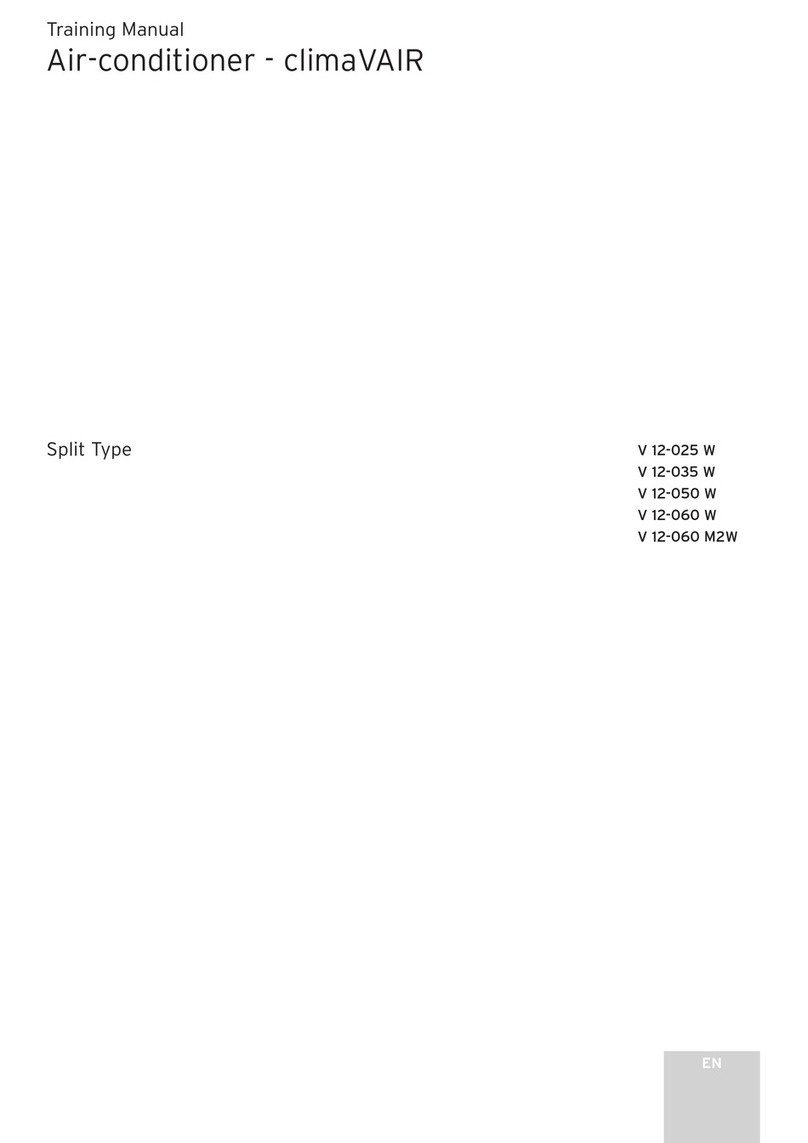
Vaillant
Vaillant V 12-025 HWI Training manual

Sanyo
Sanyo KS2432 instruction manual

GE
GE AEC14 Owner's manual and installation instructions
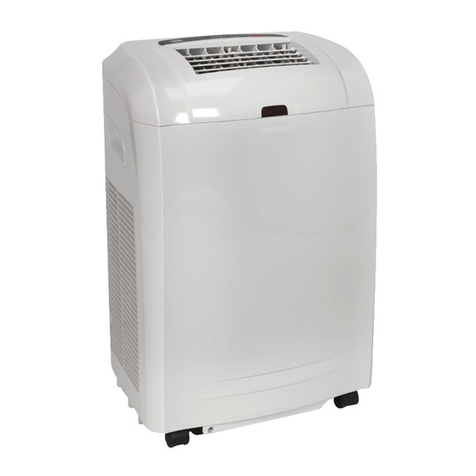
Sealey
Sealey sac9000.V3 instruction manual

Panasonic
Panasonic CS-WU12VKYF Series operating instructions

Mitsubishi Electric
Mitsubishi Electric PLA-M100EA installation manual
